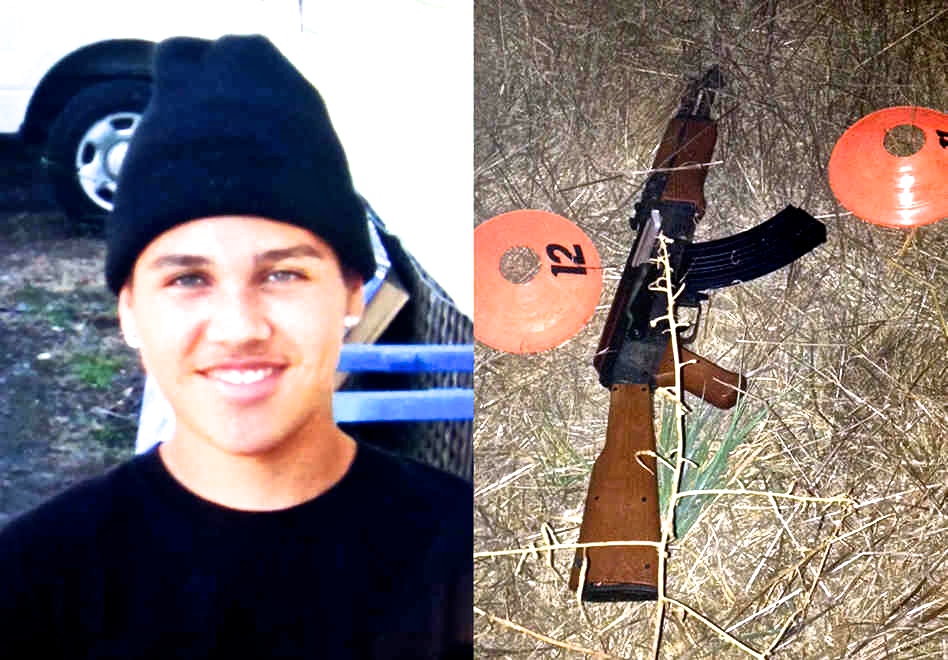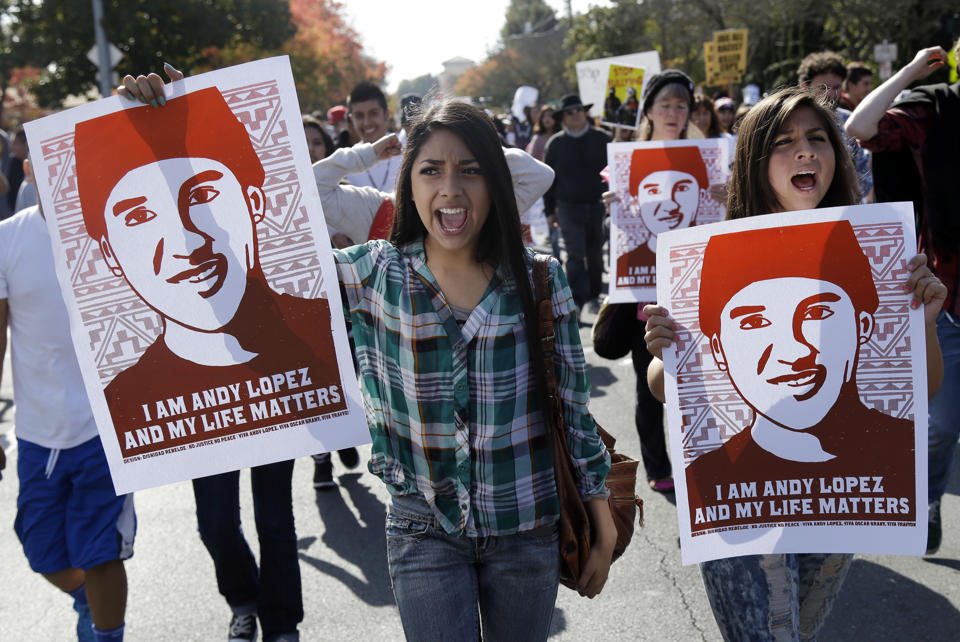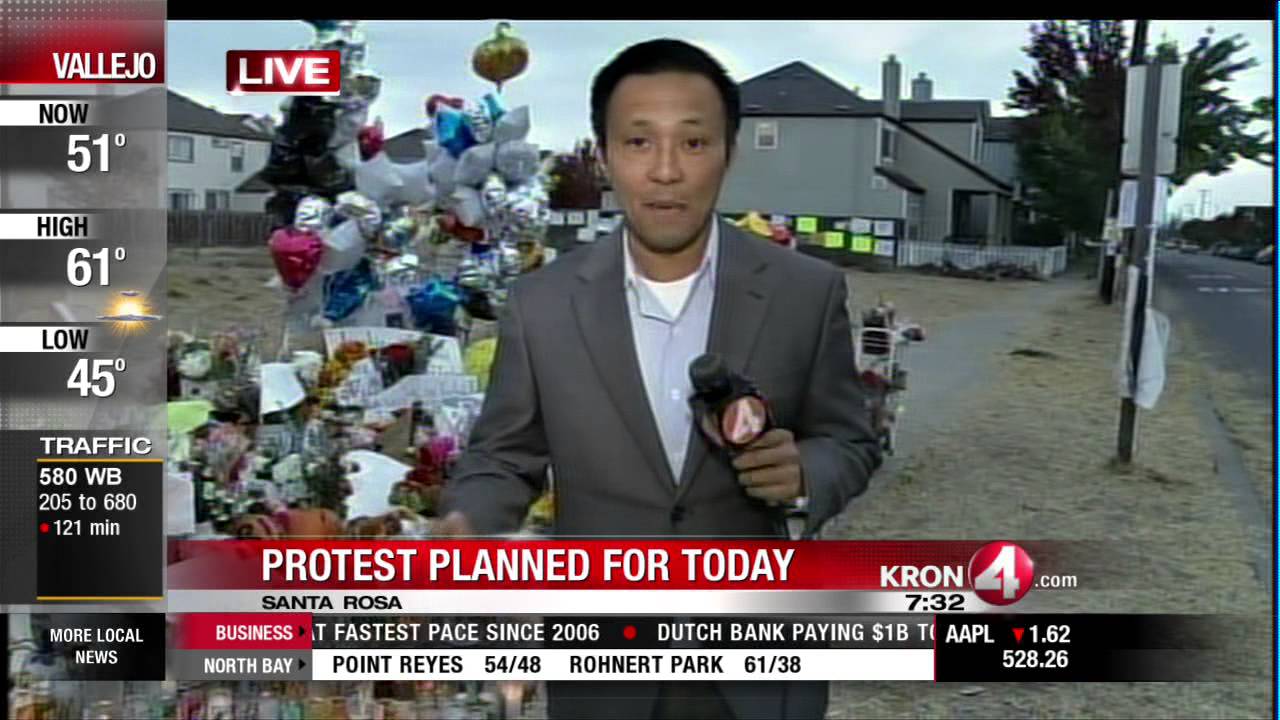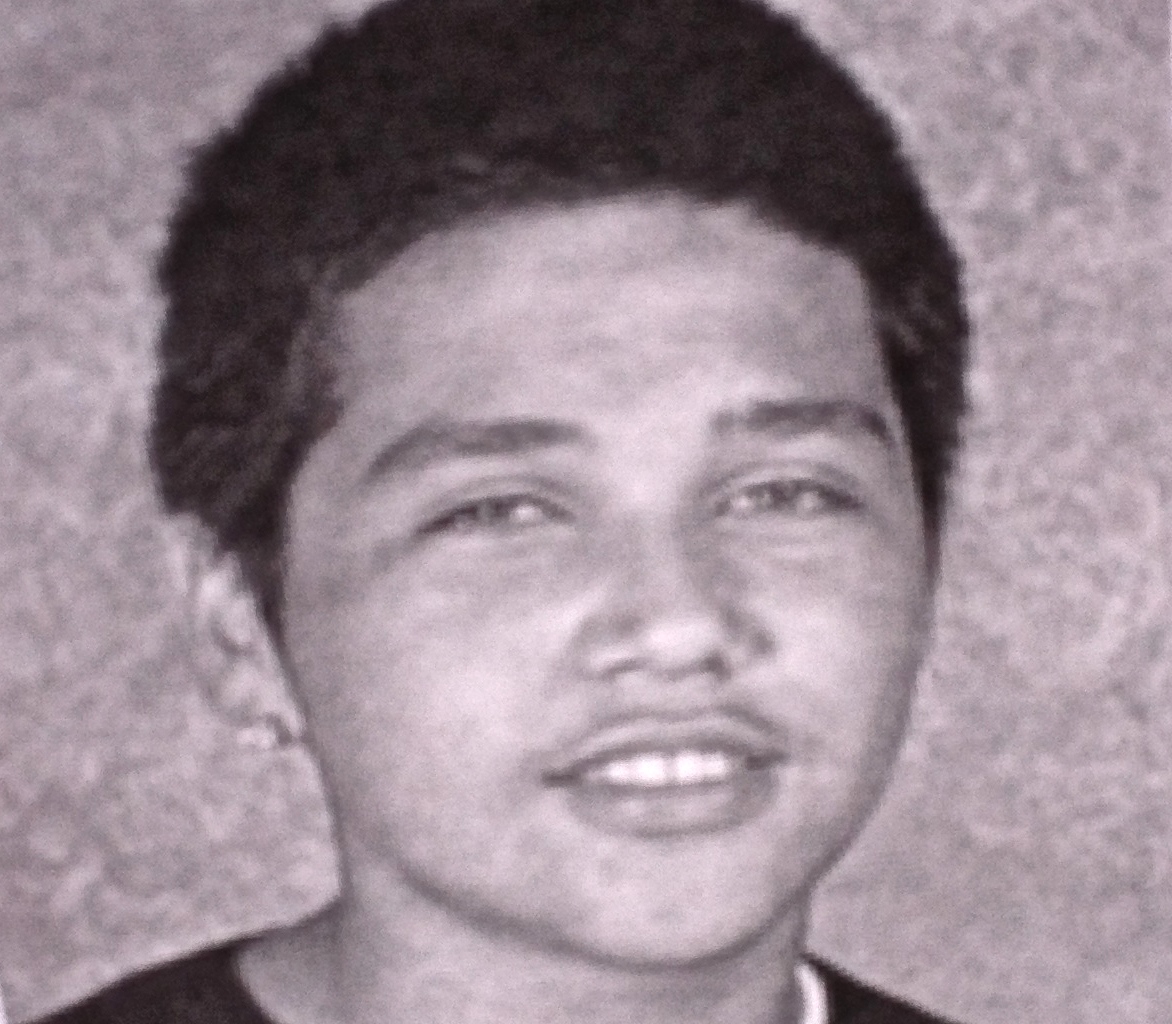SANTA ROSA, Calif. — On the eighth straight day of mourning and mass protests, hundreds of youths, families and residents marched Wednesday evening to Santa Rosa's central square to demand justice for the killing last week of 13-year-old Andy Lopez — shot seven times on the street by a sheriff's deputy who mistook the boy's airgun for an assault rifle.
The killing has outraged Latinos and the broader community here of 160,000, located in California's wine country one hour north of San Francisco, where thousands — many of them teenagers in middle school like Lopez — have streamed into the streets in recent days calling for new police laws and the swift punishment of officer Erick Gelhaus, an Iraq war veteran and former sergeant who was a known advocate of using deadly force in conflict situations.
Gelhaus was on a routine patrol through Southwest Santa Rosa's predominantly Latino neighborhood on Tuesday, October 22, when he saw Lopez carrying what he believed to be an AK-47. After phoning in a “suspicious person report,” Gelhaus ordered Lopez to turn around but within seconds, before the boy had a chance to react, Gelhaus shot him with seven rounds.
The second deputy traveling with Gelhaus, who never fired a shot, said he didn't even have time to get out of the vehicle before the boy lay fatally wounded on the ground.
Prayer vigils, a funeral, daily marches and rallies for the slain Lopez have now overtaken the city and show no sign of abating. At least two of the marches were attended by over 1,000 people, and the steady sky patrols and surveillance by helicopters have added to the tension in the city. More events are scheduled as the community's cry for justice mounts.
"Sheriff Wanted 4 Murder” read signs posted on fences in Latino neighborhoods and held at rallies. “Andy, Andy, Andy!” chanted the mourners, and "Andy Lopez did not have to die!" The boy's handsome young face has covered the front page of newspapers for days and is now showing up on sweatshirts and t-shirts around the city.
“Andy was nice and kind. He tried to make everyone laugh,” a classmate testified at the rally’s open mic. “He loved basketball and boxing,” said another student from his school, who vowed to follow the court case against the deputy to see that justice is served.
Before Wednesday's march, a trio of teenage Latino boys stood in sweatshirts emblazoned with Lopez's image. "He was our age, I've never seen anything like it," said Jaime, 15, who knew Lopez. "He was a good person to be around, he was never causing problems."
"It's the police's fault," he added. "I'm here to get justice — to stop police brutality."
The largest march, held Tuesday, was attended by mainly Latino middle school, high school and junior college students, who took over all four lanes of central Mendocino Avenue, stopping downtown traffic. Later, children along with their parents and hundreds from the community convened at the Sheriff’s Office — which had been “Closed Until Further Notice” — to air their anger and grievance.
Armed deputies surrounded the building, standing in full riot gear with helmets and shields. Snipers on the roof held assault weapons while a helicopter circled overhead. Additional tactical squads were waiting to be bussed in, if necessary. No arrests were made of the peaceful demonstrators, indicating once more an overreaction by authorities to what they perceived as a public "threat."
On the Wednesday march, dozens of low-rider cars followed the police escort as people of diverse cultures and ages walked together slowly, shoulder-to-shoulder. Truck drivers honked in support, eliciting cheers from the crowd. Teresa Carrion, from 100 Thousand Poets for Change and one of the organizers, described it “more like a ceremonial procession than a march.”
A KBBF radio reporter said the Wednesday gathering was one of the most ethnically diverse marches he had ever seen in Santa Rosa, the largest city in Sonoma County. About 30% of Sonoma County is Latino, the fastest growing population. However, many communities here remain segregated. Whereas Lopez's killing was potentially racially divisive, the tragedy has sparked a sense of multi-cultural unity that appears more than anything to be connecting people.
“We don’t need war veterans shooting everything that moves,” former Sonoma County supervisor Ernie Carpenter told the daily Press Democrat.
The outcry over Lopez's killing drew people from the San Francisco Bay Area to march in Santa Rosa. The story has been broadcast in social and mainstream media around the world, even appearing on the front pages of European dailies — evoking, for many, the killing last year of African-American youth Trayvon Martin in Florida.
“This officer should be prosecuted for murder,” said Oakland attorney John Burris, speaking at the Tuesday march. Burris was one of the attorneys to win a conviction for involuntary manslaughter of the police officer who killed Oscar Grant in an Oakland subway station in 2009. A $1.5 million settlement was won for Grant’s family.
Young Martin Luther Kings Being Born Today
Various speakers captured the range of emotions felt at the vigil which followed Wednesday's march. “A lot of young Martin Luther Kings are being born today,” observed Alicia Sanchez of KBBF bilingual radio. “Presente, Andy!” chants followed in Spanish.
“There is a war on children of color here,” commented Abraham Entin of the Sonoma County Peace and Justice Center. “The police have been militarized and trained to shoot to kill. They are supposed to serve and protect, but they see the people as the enemy.”
“I am here to pray with people and offer comfort,” added Kathleen Robbiano, a secular Franciscan. “In the name of Jesus, we want Justice for Andy,” read a sign held by one of the many mothers who attended the rally with her child in a stroller. Various Catholic, Protestant and Jewish clergy have been visible at most of the events throughout the week.
Mourning and angry mothers, such as Adrianne Desantis, whose son Richard was killed by Santa Rosa police in 2009, made their presence felt. “How about talking to the person in question, in a non-threatening manner? The old refrain of ‘I thought he had a gun’ or ‘It was a quickly evolving situation’ just do not wash any more," she said. "We pay officers to think on their feet and to be courageous.”
At the October 28 funeral for Lopez, many wore white, Andy’s favorite color, as requested by the family. Andy’s mother, Sujey Lopez, cradled her son’s face in the open casket for more than eight hours during the overflow visitation. The wail of his father, Rodrigo Lopez, rose above the pounding Aztec drums that accompanied the event.
Elected and School Officials Criticized
Most local elected officials have refused to speak out, and some have even shut their offices and public hearings to constituents who want to express their concerns about the killing. The Santa Rosa School District openly discouraged students from attending the Tuesday march, where they could witness and practice their constitutionally-guaranteed rights of free speech and free assembly.
Such authorities may be in for big surprises if the movement continues to grow and galvanizes people to take further action. Perhaps authorities fear people participating directly in democracy, rather than merely reading about it and being managed by those authorities. If officials were really interested in the safety of children, as they claim, they would work to ensure that war-time killers like Gelhaus are not allowed to drive the streets with badges and weapons.
Santa Rosa City Council member Gary Wysocky defied his colleagues and attended the Tuesday march, where he commented that the killing is “a terrible tragedy.” Supervisor Susan Gorin also joined the Wednesday march.
“I’m really disappointed in our so-called leaders who did a lot of fear mongering,” Santa Rosa school board member Laura Gonzales commented at the Tuesday rally, according to the daily Press Democrat.
The Sheriff’s Office’s colleagues at the Santa Rosa and Petaluma police departments are in charge of the investigation, and another law enforcement body — the FBI — has also gotten involved, signaling that the case may be getting taken more seriously on a federal level than a local one.
Many are calling for an independent civilian review body. The U.S. Commission on Civil Rights recommended one for Sonoma County in 2000. That has not happened yet, and 57 more deaths involving law enforcement officers have happened since then. A lawsuit against the 2007 killing of Jeremiah Chass by a sheriff’s deputy was settled for $1.74 million for the family.
Protecting Deputy Gelhaus
The Sheriff’s Office is taking “measures to protect Gelhaus,” according to the Press Democrat. But who is taking measures to protect the public from further killings by trigger-happy Gelhaus and others who may be among the 275 deputies whom Gelhaus teaches?
Why might one be concerned about Gelhaus, who is an instructor of the deputies and at a firearms school in Arizona? He sees law enforcement as a “contact sport” and a "calling," according to articles that he writes for SWAT magazine.
“Today is the day you may need to kill someone in order to go home,” Gelhaus wrote in a 2008 SWAT article, where he is a staff writer and contributes many articles and online comments, some of which are now disappearing from the Internet. October 22 was such a “day,” and perhaps not the only one, that military veteran Gelhaus killed someone.
“If you cannot turn on the ‘Mean Gene’ for yourself, who will?” Gelhaus asks in one article. But what is that “mean gene?” Did Andy Lopez have it? Doubtable, based on what his friends say about him. He has been called a “good kid” from all quarters.
Gelhaus exemplifies the increasingly militarized police forces in the United States, especially as more veterans return from wars and look for work in the poor economy back home. From the perspective of this shocked community, Gelhaus seems to have taken what he learned in the killing fields of the American war in Iraq into the streets of Santa Rosa. But who here is “the enemy,” and who are the “bad guys”?
Is Erick Gelhaus the kind of man who should be roaming the streets of Santa Rosa, or any American city, with a badge and loaded weapons as if he had a license to kill?
District Attorney Jill Ravitch asked for "patience" in a recent press release. A better time and place for patience was when Gelhaus, on a routine patrol, saw Andy in the neighborhood where he was born and lived, called him in as a “suspicious person,” and ten seconds later put seven bullets into his body, including one in his buttocks.
“Suspicious?” Because he is a brown-skinned youth walking home in the neighborhood where he was born? Because he was wearing a “hoodie,” as was Trayvon Martin when he was murdered? No one had called 911, but Gelhaus felt the boy was a “threat.” Andy carried a toy rifle.
Fortunately, the other deputy at his side responded appropriately, with patience, and did not fire a single shot. People have thanked that deputy and the good law enforcement officers who exercise caution and restraint even in fearful, dangerous situations. The police force in the small town of nearby Sebastopol is characterized by officers who practice community policing. They are dedicated to serve, protect and help provide peace.
Sheriff Steve Freitas and Sonoma County Board of Supervisors chair David Rabbitt have expressed “complete confidence in the investigation” by the police departments of Santa Rosa and Petaluma. But might that produce a “code blue” response of “you scratch my back, I’ll scratch yours?”
Perhaps Gelhaus was following his office’s procedures. If so, such Wild West “shoot first and ask questions later” protocols need to be changed, or yet more innocent people will be killed. Officials seem more interested in “damage control” than communicating openly with those they represent. Perhaps they are “closing ranks” to support the Sheriff’s Office?
The public demands more than “patience.” It continues to mount a non-violent campaign for justice. After the killing of African-American children in the South, Dr. Martin Luther King, Jr. was not patient and did not back off. He came forward with more than patience — with determination and peaceful direct action. Gandhi and Nelson Mandela were also patient at appropriate times and militant at other times.
Some suggest that more law enforcement officers wear video cameras. “We ought to demand that the sheriff’s office start using these,” writes Sebastopol resident Jonathan Greenberg. “This is about accountability, transparency and bringing an out-of-control, militarized, over-armed police force into the expectation that the people who license and pay their salaries need and expect.”
A New York Times article in August reported that the use of body cameras in Rialto, California, reduced the “use of force by officers by almost 60 percent” over the last 12 months. During that time as well, “the number of complaints against officers fell by 88 percent.”
The public and authorities can, and should, do more to restrict the police following this and other violent actions. Otherwise, it is likely that as more veterans return from wars and go into law enforcement, American police will become more militarized with more deadly weapons and act more violently, as they bring overseas wars back home.
The Sheriff’s Office has broken the trust of the community it is supposed to protect, especially its people of color. Many law-abiding residents are saying that they fear law enforcement officers more than criminals.
“What about the corporations that make and profit from deadly toys and a society that accepts this?” asked Berkeley public school teacher Larry Stefl. “What do such modern toys say about our culture? Who benefits? What are we teaching our youth?”
Shepherd Bliss teaches college, farms and is a member of the Veterans Writing Group. He can be reached at 3sb@comcast.net.
3 WAYS TO SHOW YOUR SUPPORT
- Log in to post comments















